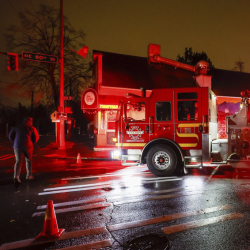 By Teresa Wiltz, America's Wire
By Teresa Wiltz, America's Wire
WASHINGTON — While achievement levels have improved considerably for minority elementary and middle school students, studies show academic performance among high school age African Americans and Hispanics has fallen to levels not seen in 30 years.
How prevalent is the achievement gap at the high school level?
On average, math and reading skills for African American and Latino high school seniors are at roughly the same level as 13-year-old white students, according to a November study put out by the Washington-based advocacy group Education Trust.
"We take kids that start [high school] a little behind and by the time they finish high school, they're way behind," says Amy Wilkins, vice president for government affairs and communications at Education Trust.
"Education is supposed to level the playing field," adds Wilkins. "And it does the opposite. … While many people are celebrating our postracial society … there is still a significant hangover in our schools."
African American and Latino students have made little to no progress in 12th-grade reading scores since 1994, according to the study, continuing to lag behind white students. Math achievement has also remained flat, with the gap between white students and those of color widening.
Causes for the disparity include: lowered expectations for students of color, income inequality and a lack of resources in low-income school districts, unequal access to experienced teachers, an increase in "out of field" teachers, and an "unconscious bias" among teachers and administrators.
These factors, experts say, produce an opportunity gap for students of color.
"A 12th-grade education in a more affluent neighborhood is not the same as the education in a less affluent neighborhood," says Dominique Apollon, research director with the non-profit Applied Research Center. "Top students in low-income schools don't have the opportunity to be pushed further and further."
School advocates say students of color, regardless of class, are frequently confronted with lowered expectations and requirements from teachers and administrators. Students in low-income schools are more likely to be given an "A" for work that would receive a "C" in a more affluent school, the Education Trust study showed.
They are also less likely to be given advanced-level coursework, an issue John Capozzi, principal of Elmont (N.Y.) Memorial Junior-Senior High School, where a majority of students are African American and Latino, sees as a civil rights issue.
"They have preconceived notions about minority kids," says Capozzi of his fellow educators and accreditation officials. "A large part of my job . . . [is] dispelling the stereotypes of our kids. It's long been embedded in society."
"African Americans and Hispanics have been denied access to the more rigorous courses," Capozzi says. All students, he adds, "should be thrown into vigorous classes" and be given proper academic support to ensure their success in college and work.
According to Education Trust, more white high school graduates were enrolled in college prep courses than were their African-American, Latino and Native American counterparts. Often, schools with large minority populations do not offer advanced classes.
Pedro Noguera, professor of education at New York University, notes, "Where there's tracking, [you have] obstacles to getting into the more rigorous classes, and the teachers aren't that committed to teaching. Those are all signs of a dysfunctional culture."
Even a middle-class background is no guarantee that minority students won't experience such obstacles. Wilkins says middle-class black teens are more likely to be placed in less competitive classes than their white peers, and a black child with high fifth-grade math scores is less likely to be enrolled in algebra in eighth grade, the study shows.
"A lot of the time, those [middle-class black] kids are in schools where they are in the minority," Noguera says. "If they don't have teachers that are encouraging them, they feel alienated."
Another obstacle for poor and minority students is that they are more likely than white students to have inexperienced and "out of field" teachers -- for instance, a math instructor teaching English or a science instructor teaching history. That, education experts say, is a recipe for disaster.
So is the prevalence of inexperienced instructors.
"Some of the least experienced teachers are put in classrooms with our most needy kids," says LaShawn Routé Chatmon, executive director of the National Equity Project based in Oakland. "This doesn't mean that new teachers can't serve needy students. But there is a trend of large numbers of teachers who aren't fully prepared."
The result? According to Chatmon, inexperienced teachers inadvertently perpetuate the achievement gap. Students performing below their grade must be taught at an accelerated level, she says. Teachers must be "warm demanders," showing students respect, encouraging them to be partners in their learning and communicating clearly that they are expected to master the subject matter, Chatmon says.
This is particularly critical in the early years of high school when students learn groundwork for more advanced coursework.
"All the research shows that ninth grade is a pivotal year, for all students, but in particular minority students," Capozzi says. "If you don't catch them in ninth grade, the rise in dropouts increases dramatically."
A longer version of this article appeared earlier on America's Wire.
America's Wire is an independent, non-profit news service run by the Maynard Institute for Journalism Education. America's Wire is made possible by a grant from the W. K. Kellogg Foundation. For more information, visit www.americaswire.orgor contact Michael K. Frisby at [email protected].
Portland and Seattle
Free Subscription to Breaking News
Free Subscription to Breaking News























































































































































































































































































































































